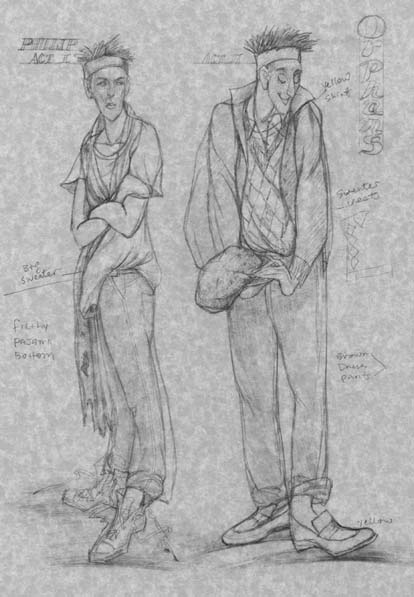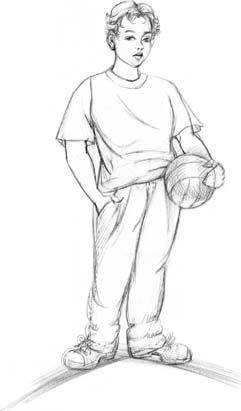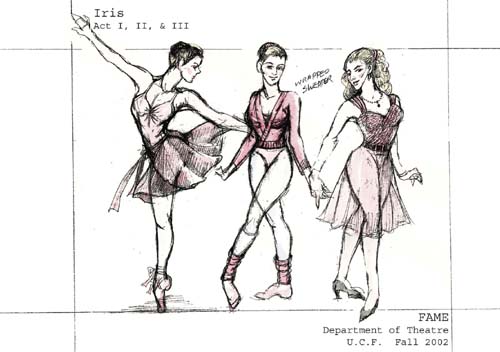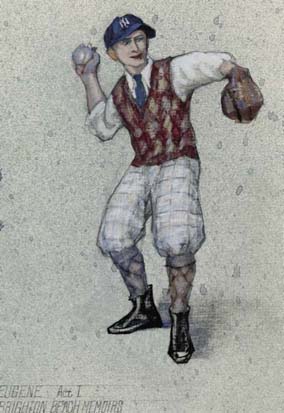3
Figure and Facial Variations
CHARACTERISTICS OF DIFFERENT AGE GROUPS
Characters in plays are a mixture of different figure types of young, old, thin, heavy, short, and tall. Knowing how to portray these characteristics and differences will help a designer portray each individual character effectively. A designer must know how to create practical costumes that will fit the criteria and attributes of a particular character.
The elements and principles of design are the fundamental foundation and key for creating and developing character figure drawings. Use various line qualities to demonstrate smooth and soft, or rough and structured silhouettes; use balance to control negative and positive space and body gestures and proportions; use contrast to accentuate fabric textures and body types; use rhythm to create body movements with draping garments; use color schemes to support and enhance your design concept; use emphasis to find the focal point of your interpretation; and use unity and harmony on the overall design ideas to keep them focused and consistent as a whole.
When drawing a child's figure, no adult proportions of the body should be considered.
When drawing a child and an adult next to each other, it is easier to show the child, because you can make the figure shorter. But if you are doing a play with only children, you will have no adult figure for comparison, so all the characters in the play need to be proportioned to a child's body. Whether you do a play with all children or with only some, the children need to be measured and drawn correctly to achieve an accurate and skillful design.
The drawings in Figures 3-1 through 3-6 show differences of the body types in the figures' facial expressions, actions, and gestures. Notice how the body changes at each stage of life while holding a ball. The purpose here is to show that just creating a short figure as a child or a wrinkly face as a senior is not enough. Body attitudes and actions are important elements that cannot be neglected.
Figures of differing ages are drawn with equal heights to emphasize proportions and each age group's common actions. Through this exercise, you will understand more about body proportions and attitudes, and you will be able to draw precisely both children and adults, and both thin and heavy bodies.
Chapter 1 discussed body proportions; this chapter explains more about the proportions of the body according to each body type.
Children's Faces and Body Types
Generally speaking, children's heads are usually bigger in proportion to their bodies. A toddler's figure is about four heads tall. It is identified by a big head, small neck, chubby body, short legs, and curved body-contour lines. A four- to six-year-old body is five heads tall, with a big head, small neck, chubby body, and longer legs. A seven- to twelve-year-old body is seven heads tall and slimmer. Children's foreheads seem bigger than adults' foreheads. Whereas the eye position of adults is located at the halfway point of their head's length, the children's eye position is below the halfway point. Children's eyebrows sit at the halfway point. A child's iris is relatively bigger, so you see less of the white part of the eye. The eye is very clear, transparent, and crystal-like. Children's noses are short, and children have round cheeks. Children's faces are angelic and radiant. They reveal happiness, innocence, purity, curiosity, wonder, desire, life, and hope. Children's facial features convey these naïve characteristics and give children life and spirit.
3-1 Toddler
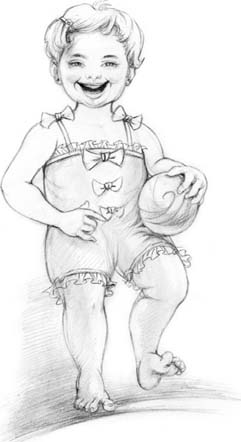
3-2 Four to Six Years

3-4 Design Sample of Children's Bodies—Tom Sawyer

Teenagers' Faces and Body Types
Teenagers are between the ages of 13 and 17. The proportions of their bodies are almost fully developed. They are eight heads tall but slimmer than adults. A teenage boy has less muscle mass than an adult male. Teenagers' bodies display youth, individuality, suppleness, boldness, insecurity, intelligence, beauty, superficial minds, experimentation, health, and innocence. When drawing a teenager's body, keep a sense of looseness and freedom, and let the adolescent spontaneity seep through the actions. Teenagers' bodies and limbs should be relaxed and active, and their body language should show overconfident attitudes. Refer to Figures 3-7 through 3-11.
Youths' Faces and Body Types
Youth starts at 18 and progresses into the late 30s. The body is now fully developed, and this age group is at the pinnacle of life. Drawings of this age group must unveil energy, hope, high spirits, pursuits, education, desire, beauty, love, health, glamour, elegance, charm, strength, and experimentation. This group cares most about physical appearance. Drawing bodies of youths is relatively easy, because their bodies have almost no imperfections (see Figures 3-12 through 3-19). All bodies are different, but there is a basic appearance for bodies in this group, as in any other group. Female bodies have beautiful curves with an arching back, a small or wide waist, full and large breasts, and a smooth body and face. Male bodies possess beautiful and prominent bone structure, angular features, and muscles. They are handsome, strong, and healthy. When you draw the figures, keep in mind that the female body has smoother curves and the shoulder line is narrower than the hipline. The male body has angular shapes, and the shoulder line is broader than the hipline. Bodies in this age group are upright with weight over the feet and no slumping at the spine. Before you begin drawing, you should be aware of these elements.
Middle-Aged Faces and Body Types
When people become middle-aged, they tend to lose elasticity in their skin, their beautiful, defined curves, and their healthy plumpness. Middle-aged people gain success in their careers along with gaining weight at their waistlines, bellies, and everywhere else. Under-eye bags and lines are apparent on their faces, and their legs and arms become heavy and sag. Some middle-aged people also begin to show a sagging back and silver hair.
In middle-aged bodies, illustrate overweight flabbiness and sagging flesh. The bone structures of middle-aged bodies may be the same as in youth, but the flesh has changed shape and consistency, much of it due to sun exposure. The muscles of middle-aged people diminish in firmness, smoothness, and angularity. They may possess a double chin, and their skin color becomes dull and sometimes age-spotted. See Figures 3-20 through 3-24.
3-7 Teenager's Body
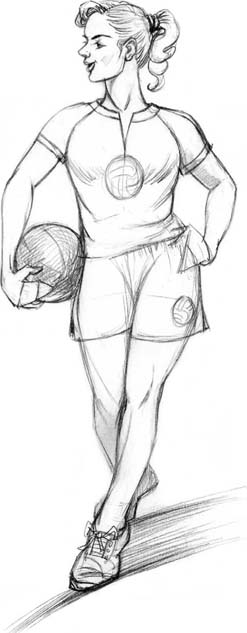
3-11 Design Sample of Teenager's Body—Brighton Beach

3-12 Female Youth Face and Body

3-14 Design Sample of Youth's Body—5th of July

3-15 Design Sample of Youth's Body—5th of July

3-17 Design Sample of Youth's Body—5th of July

3-18 Design Sample of Youth's Body—5th of July

3-20 Middle-Aged Female Face and Body

3-21 Middle-Aged Male Face and Body

3-24 Design Sample of Middle-Aged Body—5th of July

Elderly Faces and Body Types
When old age arrives, one's bone structure changes. The spine is no longer lean, strong, and straight, as in youth. The muscles of the body weaken and droop. A humped back and prominent belly are characteristics of seniors' bodies. If the teenager is like the beginning of a blooming rose, then the senior is the withering rose. It is simply the force of nature that we all experience in our later years.
We emphasize the smoothness, radiance, strength, and durability of youthful bodies; the focus for bodies of old age is on the skin's dullness and dryness, age spots, creases, wrinkles, folds, drooping skin, hanging flesh, and a forwardly bent spine, just to name a few. To reveal these characteristics well, use proper lines, highlights, and shadows.
Older bodies can be thin or heavy. A thinner body reveals more of the protruding bone structure and develops more deep creases and wrinkle lines on the surface of the skin. A heavier body will usually form more folds and bags with puffed skin rather than deep wrinkles. See Figures 3-25 through 3-28.
3-25 Elderly Face and Body
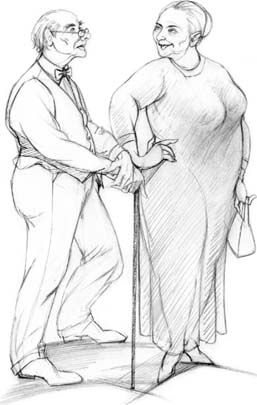
3-26 Design Sample of Elderly Face and Body—Elves and the Shoemaker

3-28 Design Sample of Elderly Face and Body—Cinderella

CHARACTERISTICS OF DIFFERENT FIGURE TYPES
Heavy Body Types
Styles of beauty change throughout time and culture. Today's ideal of beauty is a slim and slender figure, so weight problems are a constant concern. But traditional Chinese fine arts, figures in frescoes, sculptures, paintings, and pottery all present humans as full and round. Almost every figure has a double chin, big ears, and a plump body. A full and round body is associated with happiness, health, wealth, grace, nobility, power, and beauty. It has been the standard of beauty and attractiveness for thousands of years. Even today, the brilliance and power of Chinese fine artwork is being shown. What was considered the ideal woman in classic Roman times would be considered very heavy by today's standards.
Large, heavy bodies carry more fat tissue than thin, bony bodies (see Figures 3-29 through 3-31). Fat tissue wraps thicker around the skeletal structures than on bony bodies. When drawing a heavy body, start with basic body proportions as discussed in Chapter 1. Use curved body contour lines and fat tissue. If sags and bags show, such as a double chin or big belly, use fat and soft tissue rather than sculpted muscles. Emphasizing softness and roundness is the key, and stretching the tightness of the clothing will help to produce a suitable image.
3-30 Large and Heavy Body Types
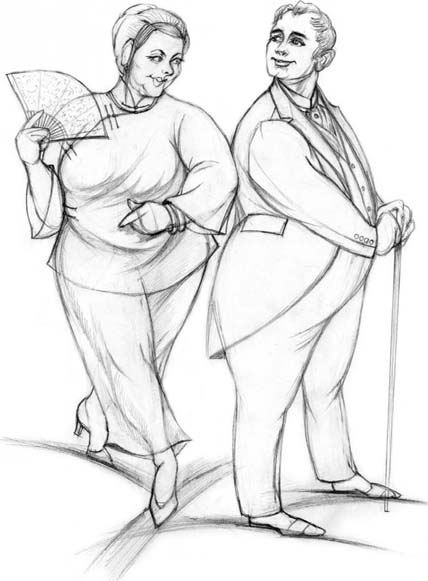
Thin, Tall, or Short Body Types
A thinner body usually looks taller, and the head seems smaller; whereas the head of a short body looks larger, and the body may seem chubbier or bulkier. In China, nicknames such as electric pole, eel, ribs, or stick refer to a thin, tall body. When I create a thin body, I often think of these metaphors to inspire my imagination. Using design principles as my guide is a discipline in developing spirited character drawings and establishing effective figure poses and actions. Contrasting the body types, the thin body is very bony and crisp, and angular lines are proper for drawing the figure; curved lines are often used for female and heavy figures. The short body can be heavy or thin. It is incorrect to draw a big or small, thin or thick, narrow or wide figure without employing the principles of scale and proportion. Scale refers to the size of one object in relation to another. The principles of contrast and scale will help you start the figure.
Basic proportions of the body can apply either to thin or heavy figures (see Figures 3-32 through 3-34). However, when drawing a thin, tall body, you may cheat a little by giving a little stretch to the bone structure to emphasize the narrow, long appearance. When drawing a short body, you can shrink the bone structure a little to emphasize the short, small look. This up- or down-scale method is utilized purposely for developing character drawings.
The head of a thin, tall body generally is smaller than the head for a short, chubby body. In this case, the eight-heads-tall proportion technique may not fit in these specific figures. The thin, tall figure can be eight-and-a-half heads, and the short figure can be five to seven heads tall.
To produce an accurately proportioned body, simply keep the crotch as the dividing line that splits the upper and lower bodies in half. Then, according to the length of the torso, determine the length of the arms and the location of the bust, waistline, and pelvis line. This principle can be used for any adult body type. Keep in mind that a larger head causes the body to look shorter, and a smaller head gives the body a taller illusion.
3-33 Design Sample of Tall and Thin Body—Orphans
